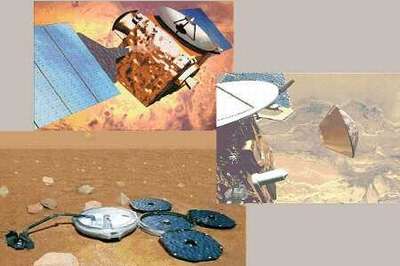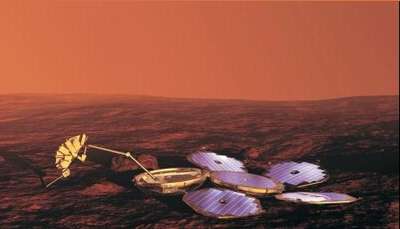Mon, Jun 02, 2003
First Ever European Visit To Red Planet
The wind stirs the dust around the former Soviet Cosmodrome at
Baikonur, in Kazakhstan. On the launch pad, a Russian-built Soyuz
rocket, tipped by a probe called "Beagle II." If all goes according
to plan, by December, the Beagle will have landed on the Martian
surface and begun looking for signs of primitive life on the Red
Planet.

An Interplanetary Mission At Bargain-Basement Prices
The European Mars mission is a study in economic space flight.
The Beagle II cost about $73 million to develop and build.
Management of the project has been largely turned over to private
industry and academia. Instead of launching the probe from the
European Space Agency's facility in South America aboard an Ariane
rocket, mission leaders decided to go to Baikonur and use the
less-expensive, more reliable Soyuz rocket. The launch will be
number 1,677 for the Soyuz program.
Total price tag for the European mission: approximately $300
million.

Red Planet - Cursed Planet?
"Mars is bad luck for space and a real difficulty for us," ESA's
science director David Southwood told Reuters. "If we were sailors,
I think we would be very superstitious about going to Mars."
Indeed, 20 of the past 30 missions to the Red Planet have ended in
something less than success. But Southwood told Reuters that
superstition won't impede the Mars Express project from putting
Beagle II on the surface. "Maybe there was life on Mars once in the
past? We are going to seek evidence of past life ... or indeed,
even micro-organisms that are alive now," Southwood said.

The European probe won't be alone in its trek to the Red Planet,
as Mars and Earth come closer than they've been for the past 66,000
years. There are two NASA orbiters circling the fourth planet and
two more NASA landers are slated for launch later this month. The
American landers contain rovers that are bigger and more
sophisticated than the UK-developed Beagle II. But only Beagle has
that onboard chemical laboratory specifically designed to look for
prehistoric signs of life.
More News
Pilot Also Reported That Due To A Fuel Leak, The Auxiliary Fuel Tanks Were Not Used On June 4, 2025, at 13:41 eastern daylight time, a Piper PA-23, N2109P, was substantially damage>[...]
Have A Story That NEEDS To Be Featured On Aero-News? Here’s How To Submit A Story To Our Team Some of the greatest new stories ANN has ever covered have been submitted by our>[...]
From 2023 (YouTube Edition): Reflections on War’s Collective Lessons and Cyclical Nature The exigencies of war ought be colorblind. Inane social-constructs the likes of racis>[...]
Aero Linx: Colorado Pilots Association (CPA) Colorado Pilots Association was incorporated as a Colorado Nonprofit Corporation in 1972. It is a statewide organization with over 700 >[...]
High Speed Taxiway A long radius taxiway designed and provided with lighting or marking to define the path of aircraft, traveling at high speed (up to 60 knots), from the runway ce>[...]
 NTSB Prelim: Piper PA-23
NTSB Prelim: Piper PA-23 ANN FAQ: Submit a News Story!
ANN FAQ: Submit a News Story! Classic Aero-TV: One Mans Vietnam
Classic Aero-TV: One Mans Vietnam ANN's Daily Aero-Linx (07.03.25)
ANN's Daily Aero-Linx (07.03.25) ANN's Daily Aero-Term (07.03.25): High Speed Taxiway
ANN's Daily Aero-Term (07.03.25): High Speed Taxiway





